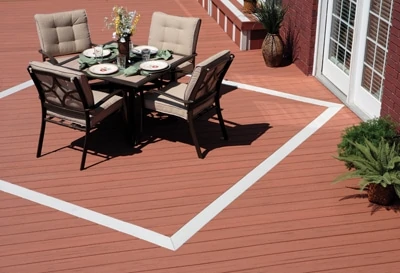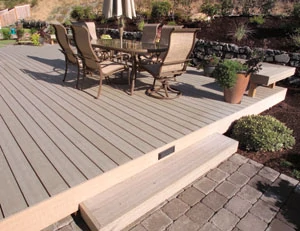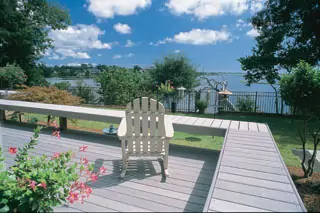When it comes to composite decking, a little research can pay off in the long run.
Composite materials are one of the fastest growing segments in the building material industry. Just as new technologies have changed the siding and roofing segments of construction, composite materials are charging into the decking arena.
However, today questions and shortcomings are becoming evident in composite decking (C-D). Everything new should and usually does look great, but problem issues surface when composite decking materials are marketed as a universal cure-all to wood’s specific problems. Rot, insects, warping, splinters, combustibility, maintenance and environmental concern for treated lumber all play into the sales.
It is important to understand that not all C-D boards are created equal. The base materials that go into making a deck board are key to how the product will perform in various geographic regions and territorial climates. Just the sun exposure and temperature range in a given day, let alone a season, will put a beautiful deck under constant stress even when it is not being used.
What distinguishes and separates C-D boards from each other over time is the type of plastic that is used. There are two types of plastic groups in use. They are as distinctly different from each other as deciduous trees are from conifers. One plastic is vinyl or PVC, which is derived from saltwater and natural gas. The other is Olefin, which is petroleum- or oil-based. Both are plastic but with very different characteristics and compositions.
Pluses and Minuses
Currently vinyl is the exterior plastic material of choice. Windows, doors, gutters, fencing, flooring and paint are a few of the products commonly accepted and used with vinyl. Vinyl products are also UV stable. They weather well and are dimensionally stable. Vinyl has a hard surface and is fire resistant. Poly-vinyl chloride products have excellent freeze-thaw resistance and a strong prior history of exterior performance.
Olefin products, as used in C-D boards, fall into three categories. First there is LLDPE or LDPE, which is commonly used for milk cartons and grocery bags. “Would you like paper or plastic” is the most common phrase associated with LDPE products. HPE has higher strengths and is usually used in higher-grade “tough” grade bags that do not tear easily. Polypropylene or PP is the highest strength of the olefins and is commonly manufactured into pipe. Olefin products lend themselves to be flexible and naturally have a softer surface than vinyl products.
As in all exterior products the enemies to plastic composites are UV rays, moisture, freeze-thaw times, fire and of course aging wear and tear. Olefin products are the dominant plastic used in the C-D lumber industry because it’s easy to process when manufacturing board compared to vinyl, and there is vast tonnage available from recycling.
Most of the plastic and the wood in both olefin and vinyl C-D boards are derived from post industrial or post consumer recycled materials. Various companies display a “built green” logo on their literature that means they are meeting a standard of recycled content from the industrial and consumer sectors.
It is really good to be reclaiming these materials, but many recycled olefin plastics are not chemically designed for sustained exposed exterior use. When these products are used for composite lumber the new boards do look good, but exposure to the elements begin a deteriorating process toward the “Land of Maintenance.” The lower the grade of plastic, the faster that trip will be.
Surface hardness and the wood used in composite boards have an interrelated roll in the potential breakdown of the product. Vinyl or PVC used in a composite is a “hard” plastic when compared to olefins. When installing an olefin, one can easily use a nail gun or screws but the soft surface tends to “pucker” up around the fastener. The raised area can be “impacted” back down so the area is back level with the fastener head. A vinyl board will stay flat and not dimple or pucker. Vinyl composites usually come with recommendations to pre-drill the ends of their boards and to use screws rather than a nail gun. The hard surface of vinyl composites also can make starting the screws a bit clumsy until one gets familiar with the product. Simply switching to a shorter drill bit alleviates much of this awkwardness. Screws labeled as C-D screws work much better with both olefin and vinyl boards than ordinary wood screws.
Embossing a surface texture seems to be more distinctive and wear-resistant on the harder surface of Vinyl composite materials. The Vinyl composites by nature, with texture, will pass the ADA slip test (ASTM-F1679) while olefins will be more slippery given comparable textures.
When olefins give off their oil to the “skin” of the board as the temperature rises, the oil dissipates from the board and it becomes more brittle. The exposed surface areas are experiencing oxidation. Heat and moisture will also contribute to the composite boards’ degeneration. Moisture swelling the wood particles, then shrinking with evaporation, loosens and breaks down the plastic bond even more. After a few good years the surface area may develop flakes like dandruff, especially if you scratch it (cats, dogs, kids, and toys and furniture).
Sealers are available for olefin boards that will adhere to the wood particles, but a few seasons later and it will be maintenance time again. This kind of soft surface will absorb stains as well as sealers. BBQ sauce, wine, grape juice, candle oil all easily penetrate into an exposed olefin board. Olefin manufacturers are no longer saying “maintenance-free and does not require sealing” in their advertising and warranties.
Stains are much less prevalent with vinyl-based composites. The harder surface does not allow much penetration versus olefin. Spills on vinyl composites usually can be removed with a deck cleaner or even warm soapy water. Light scratches in vinyl can be removed from notice with furniture polish or a liquid or solid paint stick and rags.
There are also other issues that distinguish olefin composites from vinyl composites such as fire ratings, static electricity, salty air and strength, so do your research when selecting a product. Remember, if you are looking at buying composite decking, think long-term. Get the brand that is going to address the conditions of weather, use, construction and wear for your home and lifestyle.






